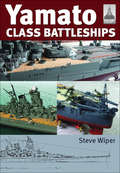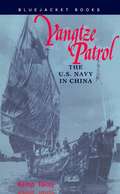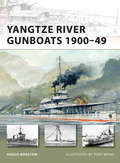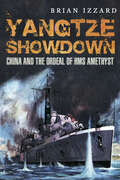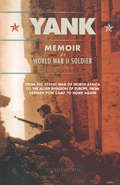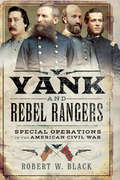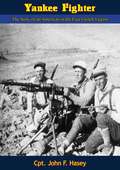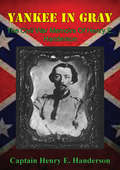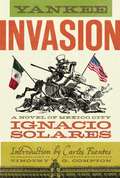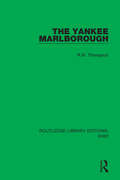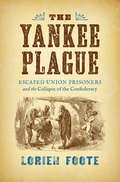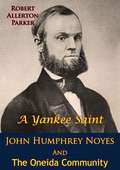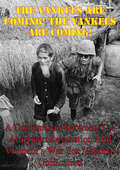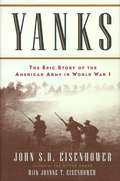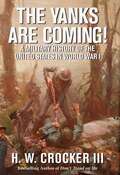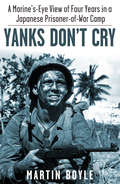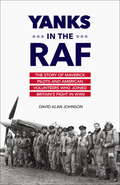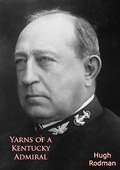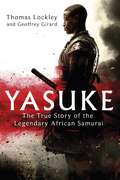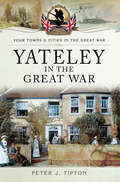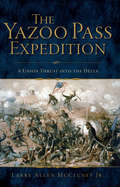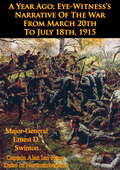- Table View
- List View
Yamato Class Battleships: Ijn Yamato Class Battleships (ShipCraft)
by Steve WiperThe Japanese Imperial Navy&’s impressive but ill-fated WWII battleships are examined in detail in this fully illustrated modeling guide. The volume in the ShipCraft series offers in-depth information about building and modifying model kits of WWII Japan&’s Yamato-class battleships. These were the largest warships of the Second World War and the largest battleships ever constructed. They also carried the largest naval artillery ever fitted to a warship. And yet, neither Yamato nor her sistership Musashi made much impact on the War. Musashi was sunk during the battle of Leyte Gulf while Yamato, deployed in a deliberate suicide attack on Allied forces at the battle of Okinawa, was finally sunk by US carrier-based aircraft. This lavishly illustrated volume takes the modeler through a brief history of the Yamato class, then provides step-by-step instruction for building a highly accurate model. Also included are hints on modifying and improving the basic kits and information on paint schemes. The strengths and weaknesses of available kits of the ships are reviewed, and the book concludes with a section on further research references.
Yangtze Patrol
by Kemp TolleyIn this entertaining history of the Yangtze Patrol, Tolley gives a lively presentation of the Chinese political situation over the past century and describes the bombing of the Panay, the siege of Shanghai, the battle of Wanhsien, and the Nanking incident. He also offers a liberal serving of colorful anecdotes and numerous period photographs.
Yangtze River Gunboats 1900-49
by Tony Bryan Angus KonstamFrom the end of the 19th century through the first half of the 20th, most Western powers maintained a naval presence in China. These gunboats protected traders and missionaries, safeguarded national interests, and patrolled Chinese rivers in search of pirates. It was a wild, lawless time in China as ruthless warlords fought numerous small wars to increase their power and influence. This book covers the gunboats of all the major nations that stationed naval forces in China, including America, Britain, France, Germany, Italy, Portugal, and Japan, and looks at such famous incidents as the Japanese bombing of the USS Patay and the dramatic escape of the HMS Amethyst from Communist forces in 1947, which marked the end of the gunboat era.
Yangtze Showdown: China and the Ordeal of HMS Amethyst
by Brian IzzardTells the &“epic tale of the entrapment of HMS Amethyst by the Chinese Communists . . . a good sea story and a look inside the early days of the Cold War&” (Strategy Page). The attack on the British frigate Amethyst on the Yangtze River by Chinese Communists in 1949 made world headlines. There was even more publicity when the ship made a dramatic escape after being trapped for 101 days. Eulogized by the British as an example of outstanding courage and fortitude, the &“Yangtze Incident&” was even made into a feature film, which depicted the ship and her crew as innocent victims of Communist aggression. The truth was more complex, and so sensitive that the government intended that the files should be closed until 2030. However, these have now been released and in making use of these documents this book is the first to tell the full story. What emerges is an intriguing tale of intelligence failure, military over-confidence and a hero with feet of clay—it is by no means as heroic as the well-publicized official version, but every bit as entertaining. While the reputations of diplomatic and naval top brass take a knock, the bravery and ingenuity of those actively involved shines even more brightly. Written with verve and including much new and surprising information, this book is both enjoyable and informative. &“[A] masterly work . . . gripped with tension and it is hard to put down . . . the feat of legends which will forever be celebrated throughout the endless history of the Royal Navy.&”—Australian Naval Institute &“A classic piece of post war naval adventure in a highly readable and well researched manner.&”—Scuttlebutt
Yank: Memoir of a World War II Soldier (1941-1945) - From the Desert War of North Africa to the Allied Inv
by Ted EllsworthTed Ellsworth was a young Dartmouth grad in 1941. In the years before the U. S. joined the Second World War effort, American men who wished to fight against Hitler were granted permission from President Roosevelt and the U. S. Congress to join the British army. <P><P>In normal circumstance, fighting for another nation's army would be an automatic forfeiture of U. S. citizenship (as noted on U. S. passports). Yank begins with goodbyes to Ellworth's young wife and family. It covers his crossing to Britain, initial stay in London, assignment to a North African tank regiment and the campaign there, participation in the invasion of Italy and the second wave of D-Day, accounts of fierce battles, being taken prisoner by the Germans and shipped to a POW camp, the camp deprivations, liberation by the Russians, and finally, the year Ellsworth spent wandering eastern Europe with no dog-tags, after the war had ended, trying to reach a city from which he could ship back home. Ellsworth had been officially MIA for over two years, and everyone assumed he was dead. The final pages detail Ellsworth's homecoming when his wife hand-delivers the beautiful and intimate note that she'd written him when he was first reported missing.
Yank and Rebel Rangers: Special Operations in the American Civil War
by Robert W. BlackThis Civil War history reveals the tactics and covert operations of both Union and Confederate rangers, guerilla forces, and volunteer units. The major battles of the American Civil War are well recorded. But while much has been written about the action at Shiloh and Gettysburg, far less is known about the cover operations and irregular warfare that were equally consequential. Both the Union and Confederate armies employed small forces of highly trained soldiers for special operations behind enemy lines. In Yank and Rebel Rangers, historian Robert W. Black tells this untold story of the war between the states. Skilled in infiltration, often crossing enemy lines in disguise, these warriors went deep into enemy territory, captured important personnel, disrupted lines of communication, and sowed confusion and fear. Often wearing the uniform of the enemy, they faced execution as spies if captured. Despite these risks, and in part because of them, these warriors fought and died as American rangers.
Yankee Fighter: The Story of an American in the Free French Legion
by Cpt. John F. Hasey Joseph F. DinneenThis is the true story of Jack Hasey, an American captain in the Free French Foreign Legion during the Second World War, who was critically wounded during the Battle of Damascus in June 1941.His bravery earned him the Order of the Cross of Liberty, the Croix de guerre 39-45 with four citations, and the Insignia for the Military Wounded. He became a Knight of the Légion d’honneur and received France’s highest World War II honour of all when he was named Companion of the Ordre de la Libération.
Yankee In Gray: The Civil War Memoirs Of Henry E. Handerson
by Captain Henry E. HandersonHenry E. Handerson, a tutor from the Western Reserve of Ohio, fifteen miles east of Cleveland, enlisted in the Confederate army on June 17, 1861...Handerson was not an ordinary soldier. His memoir is the account of a Northerner--who after only two years of residency in antebellum Louisiana decided to cast his lot with the Confederacy. ...Already a member of a local home guard company, the twenty-four-year-old Ohio-born Handerson was quickly enrolled as a private in the Stafford Guards, later Company B, of the Ninth Louisiana Infantry. The Ninth was first bloodied at the Battle of Front Royal, Virginia, on May 23, 1862, in a brisk fight with the Union First Maryland Infantry. As part of Stonewall Jackson's command, the regiment and Handerson marched and fought up and down the length of the Shenandoah Valley before moving down to Richmond to participate in the bloody Seven Days Battle. Handerson took part in the Fredericksburg battle, and later in the spring of 1863, was wounded in the neck at Chancellorsville. Lieutenant Handerson recovered from his wound just in time to reach Gettysburg on the last day of the battle there. In the Battle of the Wilderness, while carrying a dispatch, Handerson ran into an advancing battle line and was taken prisoner...and confined under poor living conditions, in a stockade in the direct line of fire from the Confederates at Charleston. Surviving this ordeal, Handerson wound up the war at Fort Pulaski, Georgia.Handerson's memoirs and his letters give a sympathetic picture of war and life in the Confederate army as seen through the eyes of a Northerner who lacked the emotional involvement of the native-born Southerners. His account of service with the army of Northern Virginia and as a prisoner of war is of particular value regarding the everyday details and incidents of a soldier's life. Important figures and Confederate heroes are treated fairly but objectively by this keen-eyed observer.-Edward Cunningham
Yankee Invasion
by Ignacio Solares Carlos Fuentes Timothy G. ComptonYankee Invasion centers on one of the most traumatic periods of Mexican history: the 1847 invasion of Mexico City by American armed forces and the ultimate loss of almost half its territory to the United States. Abelardo, who as a young man witnessed the events, narrates the novel and in its very first pages commits an act of resistance that will haunt him the rest of his life. In his old age, he begins to reflect on the history of Mexico, as well as his complicated love affairs with both his fiancée and her mother, which play out against the tumultuous backdrop of the invasion and occupation. Told with humor and pathos, Yankee Invasion paints a riveting portrait of an event that, though little known in America, still reverberates in Mexico today. Vivid descriptions capture the streets, cafés, cantinas, and drawing rooms of 19th-century Mexico City.
The Yankee Marlborough (Routledge Library Editions: WW2 #48)
by R.W. ThompsonThis book, first published in 1963, is an early biography of Winston Churchill, examining his personality and character that was woven so closely through the texture of Britain’s story in the first half of the twentieth century. In attempting to discover a complete and complex Churchill, in his character, ambitions and personal experiences, the book seeks to present a clearer insight into the events of Churchill’s life.
The Yankee Plague: Escaped Union Prisoners and the Collapse of the Confederacy (Civil War America)
by Lorien FooteDuring the winter of 1864, more than 3,000 Federal prisoners of war escaped from Confederate prison camps into South Carolina and North Carolina, often with the aid of local slaves. Their flight created, in the words of contemporary observers, a "Yankee plague," heralding a grim end to the Confederate cause. In this fascinating look at Union soldiers' flight for freedom in the last months of the Civil War, Lorien Foote reveals new connections between the collapse of the Confederate prison system, the large-scale escape of Union soldiers, and the full unraveling of the Confederate States of America. By this point in the war, the Confederacy was reeling from prison overpopulation, a crumbling military, violence from internal enemies, and slavery's breakdown. The fugitive Federals moving across the countryside in mass numbers, Foote argues, accelerated the collapse as slaves and deserters decided the presence of these men presented an opportune moment for escalated resistance. Blending rich analysis with an engaging narrative, Foote uses these ragged Union escapees as a lens with which to assess the dying Confederate States, providing a new window into the South's ultimate defeat.
A Yankee Saint: John Humphrey Noyes And The Oneida Community
by Robert Allerton ParkerConsidered to be one of the definitive biographies on John Humphrey Noyes, an American preacher, radical religious philosopher, and utopian socialist who founded the Putney, Oneida, and Wallingford Communities and is credited for having coined the term "free love".
Yankee Stranger (The\williamsburg Novels Ser. #2)
by Elswyth ThaneLOVE AND WARCabot Murray first came to Williamsburg, Virginia, in the tense autumn of 1860. He was looked upon with suspicion because he was a Yankee. Then Cabot met redheaded Eden Day.Theirs was a wild, blind young love at first sight. Whispering in her hair, what did it matter that he was a Northerner and she from the South…But then came the Civil War. With the tide of battle Cabot returned as an enemy spy. In Eden he found the hatred of a woman who has learned desire.Could the bitterness of war be softened in the arms of lovers?
The Yankees are Coming! The Yankees are Coming!: A Comparison Between The American Revolution And Vietnam’s War For National Unification
by Major Jeffrey M. Dunn USMCThis paper compares British involvement in America's struggle for independence in the late eighteenth century with the United States' immersion in North Vietnam's struggle for national unification in the twentieth.Many similarities exist between the American Revolution and the Vietnam War. Five of the most apparent similarities are examined. First, Great Britain and the United States made similar fundamental assumptions, in their respective conflicts, which proved equally flawed. Second, the distances between the combatants in both conflicts were vast. The lines of communication were extremely long. Third, similarities abound between the people involved, both generally and specifically. Fourth, both wars have a single campaign that can be described as the turning point. Though Saratoga and Tet occurred at relatively early stages in the respective conflicts, the outcomes of the wars were arguably decided after those campaigns. Fifth, the southern strategies in both wars are remarkably analogous. Both Great Britain and the United States succeeded in alienating the undecided, and arousing animosity among the common people.1. The United States became the oppressor in Vietnam, and closely emulated its enemy, Great Britain, in the Revolutionary War.2. Many patterns repeat themselves through history and within those patterns are keys to success in the future.3. The United States needs to become more proficient at searching for patterns in history (not just its own). By learning from the mistakes made by itself and others, the U.S. will make fewer mistakes in the future.
Yanks
by John EisenhowerFought far from home, World War I was nonetheless a stirring American adventure. The achievements of the United States during that war, often underrated by military historians, were in fact remarkable, and they turned the tide of the conflict. So says John S. D. Eisenhower, one of today's most acclaimed military historians, in his sweeping history of the Great War and the men who won it: the Yanks of the American Expeditionary Force. Their men dying in droves on the stalemated Western Front, British and French generals complained that America was giving too little, too late. John Eisenhower shows why they were wrong. The European Allies wished to plug the much-needed U.S. troops into their armies in order to fill the gaps in the line. But General John J. "Black Jack" Pershing, the indomitable commander of the AEF, determined that its troops would fight together, as a whole, in a truly American army. Only this force, he argued -- not bolstered French or British units -- could convince Germany that it was hopeless to fight on. Pershing's often-criticized decision led to the beginning of the end of World War I -- and the beginning of the U.S. Army as it is known today. The United States started the war with 200,000 troops, including the National Guard as well as regulars. They were men principally trained to fight Indians and Mexicans. Just nineteen months later the Army had mobilized, trained, and equipped four million men and shipped two million of them to France. It was the greatest mobilization of military forces the New World had yet seen. For the men it was a baptism of fire. Throughout Yanks Eisenhower focuses on the small but expert cadre of officers who directed our effort: not only Pershing, but also the men who would win their lasting fame in a later war -- MacArthur, Patton, and Marshall. But the author has mined diaries, memoirs, and after-action reports to resurrect as well the doughboys in the trenches, the unknown soldiers who made every advance possible and suffered most for every defeat. He brings vividly to life those men who achieved prominence as the AEF and its allies drove the Germans back into their homeland -- the irreverent diarist Maury Maverick, Charles W. Whittlesey and his famous "lost battalion," the colorful Colonel Ulysses Grant McAlexander, and Sergeant Alvin C. York, who became an instant celebrity by singlehandedly taking 132 Germans as prisoners. From outposts in dusty, inglorious American backwaters to the final bloody drive across Europe, Yanks illuminates America's Great War as though for the first time. In the AEF, General John J. Pershing created the Army that would make ours the American age; in Yanks that Army has at last found a storyteller worthy of its deeds.
The Yanks Are Coming!: A Military History of the United States in World War I
by H. W. Crocker IIIBestselling military historian H. W. Crocker III (The Politically Incorrect Guide to the Civil War, Robert E. Lee on Leadership, etc.) now turns his guns on the epic story of America's involvement in the First World War with his new book The Yanks Are Coming: A Military History of the United States in World War I. <P><P>2014 marks the centenary of the beginning of that war, and in Crocker's sweeping, American-focused account, readers will learn: <P><P>How George S. Patton, Douglas MacArthur, George C. Marshall (of the Marshall Plan), "Wild Bill" Donovan (future founder of the OSS, the World War II precursor to the CIA), Harry S. Truman, and many other American heroes earned their military spurs in "The Great War" <P><P>Why, despite the efforts of the almost absurdly pacifistic administration of Woodrow Wilson, American involvement in the war was inevitable <P><P>How the First World War was "the War that Made the Modern World"-sweeping away most of the crowned heads of Europe, redrawing the map of the Middle East, setting the stage for the rise of communism and fascism <P><P>Why the First World War marked America's transition from a frontier power-some of our World War I generals had actually fought Indians-to a global superpower, with World War I generals like Douglas MacArthur living to see, and help shape, the nuclear age <P><P>"The Young Lions of the War" -- heroes who should not be forgotten, like air ace Eddie Rickenbacker, Sergeant Alvin York (memorably portrayed by Gary Cooper in the Academy Award-winning movie Sergeant York), and all four of Theodore Roosevelt's sons (one of whom was killed)Stirring, and full of brilliantly told stories of men at war, The Yanks Are Coming will be the essential book for readers interested in rediscovering America's role in the First World War on its hundredth anniversary.
The Yanks Are Coming: The United States in the First World War
by Albert MarrinDescribes how American military forces helped the Allies turn the tide of World War I and how the United States mobilized industry, trained soldiers, and promoted the war to the people at home.
Yanks Don't Cry
by Martin BoyleYanks Don't Cry, first published in 1963, opens on the tropical Pacific island of Guam in early December, 1941, a few short days before the attack on Pearl Harbor. The U.S. Marines on Guam, neither equipped nor prepared for an invasion are quickly captured and shipped off to prison in Japan. There they began a nearly four-year imprisonment until the war's end in 1945. During those years they managed to retain the high spirits of free men, to sabotage the Japanese war effort at every opportunity as they worked on the docks and in other areas, to steal extra food rations, and, near war's end, to observe with pride the American bombing raids on Japan (while struggling mightily to free a group of Japanese schoolchildren trapped in a warehouse damaged by the bombs). The author's sense-of-humor shines through on nearly every page, which allowed him and his companions a small measure of comfort and the strength to somehow carry on. Yanks Don't Cry remains a classic recounting of life in war-time Japan for Allied prisoners-of-war.
Yanks in the RAF
by David Alan JohnsonThis is the story of American volunteer pilots who risked their lives in defense of Britain during the earliest days of World War II--more than a year before Pearl Harbor, when the United States first became embroiled in the global conflict. Based on interviews, diaries, personal documents, and research in British, American, and German archives, the author has created a colorful portrait of this small group who were our nation's first combatants in World War II.As the author's research shows, their motives were various: some were idealistic; others were simply restless and looking for adventure. And though the British air force needed pilots, cultural conflicts between the raw American recruits and their reserved British commanders soon became evident. Prejudices on both sides and lack of communication had to be overcome. Eventually, the American pilots were assembled into three squadrons known as the Eagle squadrons. They saw action and suffered casualties in both England and France, notably in the attack on Dieppe. By September 1942, after America had entered the war, these now experienced pilots were transferred to the US air force, bringing their expertise and their British Spitfires with them.As much social as military history, Yanks in the RAF sheds new light on a little-known chapter of World War II and the earliest days of the sometimes fractious British-American alliance.From the Hardcover edition.
Yarns of a Kentucky Admiral
by Hugh RodmanHugh Rodman, a graduate of the Naval Academy, Class of 1880, is best known as the commander of the U.S. Navy's Battleship Division 9, that served in the North Sea in World War I as Battle Squadron 6, an integral part of the British Grand Fleet; after the war he was Commander-in‑Chief of the U. S. Navy's Pacific Fleet.
Yasuke: The true story of the legendary African Samurai
by Thomas Lockley Geoffrey GirardWARRIOR. SAMURAI. LEGEND.The remarkable life of history's first foreign-born samurai, and his astonishing journey from Northeast Africa to the heights of Japanese society.The man who came to be known as Yasuke arrived in Japan in the 16th century, an indentured mercenary arriving upon one of the Portuguese ships carrying a new language, a new religion and an introduction to the slave trade. Curiously tall, bald, massively built and black skinned, he was known as a steadfast bodyguard of immense strength and stature, and swiftly captured the interest, and thence the trust, of the most powerful family in all of Japan. Two years later, he vanished.Yasuke is the story of a legend that still captures the imagination of people across the world. It brings to life a little known side of Japan - a gripping narrative about an extraordinary figure in a fascinating time and place.
Yateley in the Great War (Your Towns & Cities in the Great War)
by Peter J. TiptonThere were fewer than 500 houses in Yateley in WWI but with Aldershot, Farnborough, Camberley and Sandhurst close by, this Hampshire villages response to the call to arms was more prepared than most, and punched above its weight.Using contemporary evidence from many sources researched by our local history team, the Yateley Society recreates the impact of the War on our predecessors. The story of the men who left Yateley to fight -- territorials, regulars, volunteers and conscripts -- is told alongside that of the battalions of Kitcheners New Armies training in trench warfare on Yateley Common. At the same time, in the three private houses forming the Yateley Military Hospital, Yateley women of all ages were tending wounded soldiers.With its intimate glimpses into village life, this book, will fascinate anyone with Yateley connections. The names of many families in the village of 100 years ago are here, while for recent newcomers with perhaps a Victorian or Edwardian house there may be clues to the history of your homes.With its many illustrations and maps, this exploration of the social network, and social consequences of the Great War on a small community in North East Hampshire has interest for historians and general readers alike.
Yazoo Pass Expedition, The: A Union Thrust into the Delta (Civil War Series)
by Larry Allen Jr.After six failed attempts to reach Vicksburg, General Ulysses S. Grant developed a plan. The Yazoo Pass Expedition was a Union army/navy operation meant to bypass Vicksburg by using the backwaters of the Mississippi Delta. Operations began on February 3, 1863, with a levee breach on the Mississippi River. The expedition was delayed as a result of natural obstacles and Confederate resistance, which allowed the Confederate army under Lieutenant General John Pemberton to block passage of the Federal fleet. The Confederates continued to rebuff the fleet and finally defeated it in the spring. Larry McCluney examines the expedition from start to finish in never-before-seen detail.
A Year Ago; Eye-Witness’s Narrative Of The War From March 20th To July 18th, 1915 [Illustrated Edition]
by Major-General Ernest D. Swinton Captain Alan Ian Percy Duke of NorthumberlandIncludes The First World War On The Western Front 1914-1915 Illustrations Pack with 101 maps, plans, and photos.Major-General Ernest Swinton had already had a long and illustrious career in the British Army before the advent of the First World War in 1914. Appointed as the official war correspondent by the war Minister Lord Kitchener in 1914, his reporting home was the only way for the British people to follow the war as journalists were at that time banned at the front. In these dispatches from the front Swinton told the public of the bloody fighting in Flanders and the heroic efforts of the Allies to stop the German Juggernaut. So even handed and realistic they were brought together in a series of books under the pseudonym "Eyewitness" for further publication. Swinton was not a "château" general by any means and visited the front with dangerous regularity write of the fighting with real authority, often including anecdotes of the ordinary soldiers that he interviewed. The miserable conditions and bloody siege warfare of the trenches left a lasting impression on him and he looked to a scientific solution to the muddy stalemate of the Western Front. He would gain lasting fame as the architect of the "tank" project that was to revolutionize warfare in the First World War and for many years thereafter.
Year in Nam: A Native American Soldier's Story
by Leroy TecubeRecollections from a Native American about the year that he spent in Vietnam during the Vietnam War, and how it influenced him throughout his life
